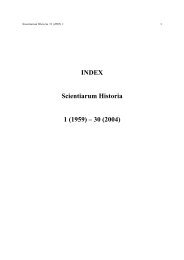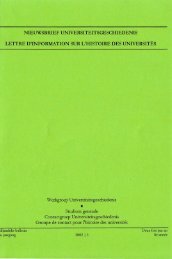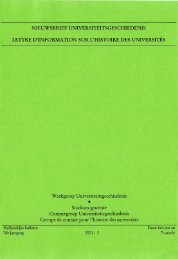the ocular harpsichord of louis-bertrand castel - Gewina
the ocular harpsichord of louis-bertrand castel - Gewina
the ocular harpsichord of louis-bertrand castel - Gewina
You also want an ePaper? Increase the reach of your titles
YUMPU automatically turns print PDFs into web optimized ePapers that Google loves.
Castel's <strong>ocular</strong> <strong>harpsichord</strong> 25<br />
celadon-green-olive-yellow-fallow-nacarat-red-carmine-violet-agate-violaceous,<br />
representing a direct analogue <strong>of</strong> <strong>the</strong> chromatic scale in music.^ Castel's next<br />
step meant a departure from music, however. Instead <strong>of</strong> permitting every colour<br />
to be <strong>the</strong> possible root tone <strong>of</strong> a major or minor scale, he wanted an absolute<br />
colour-tonic, and argued that this place was occupied by blue, <strong>the</strong> basse fondamentale<br />
<strong>of</strong> nature, because we see all colours in nature against <strong>the</strong> background<br />
<strong>of</strong> <strong>the</strong> blue sky." To make <strong>the</strong> departure from music seem less radical,<br />
however, Castel argued that in music <strong>the</strong>re is also an absolute tonic, fixed by <strong>the</strong><br />
range <strong>of</strong> <strong>the</strong> human voice, and this tonic was <strong>the</strong> standard C. Again miraculously,<br />
making blue <strong>the</strong> absolute key-colour resulted in <strong>the</strong> most perfect analogy<br />
possible: <strong>the</strong> three most important notes in <strong>the</strong> scale - tonic, dominant or fifth,<br />
and third - were now... blue, red and yellow. It was known that all colours could<br />
indeed be produced by mixing blue, red and yellow. And was not red indeed <strong>the</strong><br />
dominant colour <strong>of</strong> nature, and had not <strong>the</strong> note G "something <strong>of</strong> <strong>the</strong> warrior, <strong>of</strong><br />
anger, something bloody, something flamboyant"?'^ And was not, on <strong>the</strong> o<strong>the</strong>r<br />
hand, <strong>the</strong> interval F-B <strong>the</strong> most difficult to sing, and <strong>the</strong> corresponding colour<br />
interval fallow-violaceous a combination <strong>of</strong> "colours that are very undetermined<br />
and difficult to grasp"?''<br />
Even this perfection did not yet satisfy Castel. Five years later, in his Optique<br />
des couleurs, he combined this colour scale with <strong>the</strong> chiaroscuro to solve <strong>the</strong><br />
problems <strong>of</strong> different octaves. Just as all tones are posited between <strong>the</strong> silence<br />
below <strong>the</strong> lowest tone and <strong>the</strong> silence above <strong>the</strong> highest tone, so all colours are<br />
between <strong>the</strong> two "colourless colours" black and white. By adding <strong>the</strong> chiaroscuro,<br />
we can think <strong>of</strong> <strong>the</strong> colours as moving from black to white, in <strong>the</strong> sequence <strong>of</strong><br />
<strong>the</strong> colour scale, such that when we have completed one octave <strong>the</strong> octave<br />
colour is one "chiaroscuro unit" lighter than <strong>the</strong> prime. By a similar process as<br />
had been used to discover <strong>the</strong> number <strong>of</strong> distinct colours in <strong>the</strong> scale, Castel<br />
established that <strong>the</strong>re were exactly twelve full octaves <strong>of</strong> different chiaroscuro<br />
shades between black and white. This meant that <strong>the</strong> <strong>ocular</strong> <strong>harpsichord</strong> needed<br />
a keyboard <strong>of</strong> 144 or 145 keys. But <strong>the</strong> introduction <strong>of</strong> chiaroscuro also served<br />
ano<strong>the</strong>r purpose for Castel: as blue is always <strong>the</strong> darkest colour <strong>of</strong> any three<br />
equally dark red, yellow and blue, according to Castel, and as <strong>the</strong> darkest blue is<br />
darker still than <strong>the</strong> darkest red or <strong>the</strong> darkest yellow, we can be extra sure that<br />
The French names used by Castel are bleu-CLiadon-verd-olive-jaune-fauve-nacarat-rougecramoisi-violct-aga<strong>the</strong>-violani.<br />
For violani Castel sometimes put gris-bleu.<br />
Memoires de Trevoux, August 1735, 2me partie, p. 1663.<br />
32<br />
Ibid., September 1735, p. 1830: "quelque chose de guerrier, de colere. de sanglant, de<br />
flamboyant".<br />
Ibid., August 1735, pp. 1474-1475: "des couleurs fort indccises & fort difficiles a attraper,<br />
aussi difficiles que le/a si triton dissonant est difficile a sentir & a entonner."

















